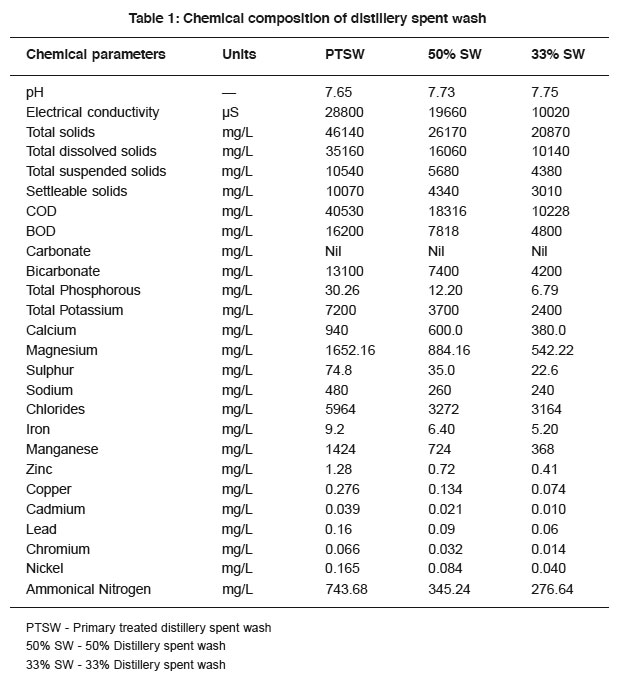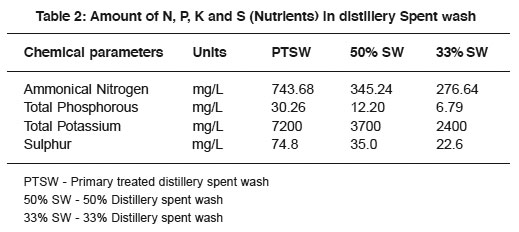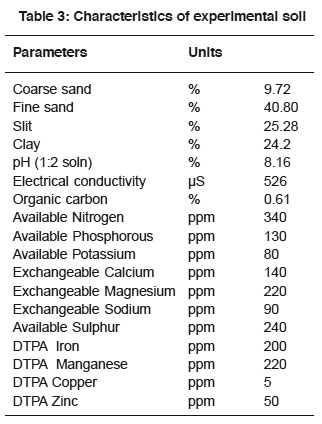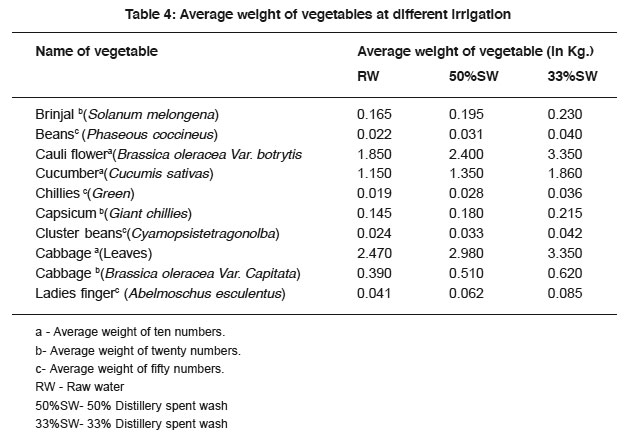Impact of distillery spentwash irrigation on the yields of some top vegetables: An investigation
C.S. Chidankumar1 * and S. Chandraju1
1
Lecturer in Chemistry,
Bharathi College,
Bharathi Nagar,
571 422
India
2
Department of Studies in Sugar Technology,
Sir M.Visweswaraya Postgraduate Center,
University of Mysore, Tubinakere,
Mandya,
571 402
India
DOI: http://dx.doi.org/10.12944/CWE.3.2.07
Cultivation of some top vegetables was made by irrigation with distillery spent wash of different proportions. The spent wash i.e., primary treated spent wash (PTSW), 50% and 33% spent wash were analyzed for its plant nutrients such as nitrogen, phosphorous, potassium and other physical and chemical parameters. Experimental soil was tested for its chemical and physical parameters. Top vegetables seeds (Namadhari and Mayhco) were sowed in the prepared land and irrigated with raw water (RW), 50% and 33% spent wash. The impact of spent wash on the yields of vegetables at their maturity periods was investigated.
Copy the following to cite this article:
Chidankumar C.S, Chandraju S. Impact of distillery spentwash irrigation on the yields of some top vegetables: An investigation. Curr World Environ 2008;3(2):251-256 DOI:http://dx.doi.org/10.12944/CWE.3.2.07
Copy the following to cite this URL:
Chidankumar C.S, Chandraju S. Impact of distillery spentwash irrigation on the yields of some top vegetables: An investigation. Curr World Environ 2008;3(2):251-256. Available from: http://www.cwejournal.org/?p=831
Download article (pdf)
Citation Manager
Publish History
Select type of program for download
| Endnote EndNote format (Mac & Win) | |
| Reference Manager Ris format (Win only) | |
| Procite Ris format (Win only) | |
| Medlars Format | |
| RefWorks Format RefWorks format (Mac & Win) | |
| BibTex Format BibTex format (Mac & Win) |
Article Publishing History
| Received: | 2008-10-09 |
|---|---|
| Accepted: | 2008-11-23 |
Introduction
Molasses (one of the important byproducts of sugar industry) is the chief source for the production of alcohol in distilleries by fermentation method. About 40 billion liters of waste water annually discharged in distilleries, known as raw spent wash (RSW), which is characterized by high biological oxygen demand (BOD: 5000-8000mg/l) and chemical oxygen demand (COD: 25000-30000mg/l) (Joshi,1994) , ugly color and bad smell. Discharge of raw spent wash into open land or near by water bodies resulting in a number of environmental, water and soil pollution including threat to plant and animal lives. Hence discharge of spent wash is a great problem. The RSW is highly acidic and contains easily oxidisable organic matter with very high BOD and COD (Patil, 1987). Also, spent wash contains highest content of organic nitrogen and nutrients (Ramadurai and Gearard, 1994). By installing biomethenation plant in distilleries, reduces the oxygen demand of RSW, the resulting spent wash is called primary treated spent wash (PTSW) and primary treatment to RSW increases the nitrogen (N), potassium (K), and phosphorous (P) contents and decreases the calcium (Ca), magnesium (Mg), sodium (Na), chloride (Cl-), and sulphate (SO42-) (Mohammad Haron and Subhash Chandra Bose,2004). The PTSW is rich in potassium (K), sulphur (S), nitrogen (N), phosphorous (P) as well as easily biodegradable organic matter and its application to soil has been reported to be beneficial to increase sugar cane Zalwadia, 1997), rice (Devarajan and Oblisami, 1995), wheat and rice yield (Pathak et al.,), quality of groundnut (AmarSingh et al., 2003) and physiological response of soybean (Ramana et al., 2000). Diluted spent wash could be used for irrigation purpose without adversely affecting soil fertility(Kaushik et al., 2005; Kuntal et al., 2004; Raverkar et al., 2000), seed germination and crop productivity(Ramana et al., 2001). The diluted spent wash irrigation improved the physical and chemical properties of the soil and further increased soil microflora (Devarajan, 1994; Kaushik et al, 2005; Kuntal et al., 2004). Twelve pre sowing irrigations with the diluted spent wash had no adverse effect on the germination of maize but improved the growth and yield (Singh and Raj Bahadur, 1998). Diluted spent wash increases the growth of shoot length, leaf number per plant, leaf area and chlorophyll content of peas (Ravi and Srivastava, 1990). Increased concentration of spent wash causes decreased seed germination, seedling growth and chlorophyll content in sunflowers (Helianthus annuus) and the spent wash could safely used for irrigation purpose at lower concentration (Rajendra, 1990; Ramana et al., 2001). The spent wash contained an excess of various forms of cations and anions, which are injurious to plant growth and these constituents should be reduced to beneficial level by diluting the spent wash, which can be used as a substitute for chemical fertilizer (Sahai et al., 1983). The spent wash could be used as a complement to mineral fertilizer to sugarcane (Chares, 1985). The spent wash contained N, P, K, Ca, Mg and S and thus valued as a fertilizer when applied to soil through irrigation with water (Samuel, 1986). The application of diluted spent wash increased the uptake of Zinc, Copper, Iron and Manganese in maize and wheat as compared to control and the highest total uptake of these were found at lower dilution levels than at higher dilution levels (Pujar, 1995). Mineralization of organic material as well as nutrients present in the spent wash was responsible for increased availability of plant nutrients. Diluted spent wash increase the uptake of nutrients, height, growth and yield of leaves vegetables (Chandraju et al., 2007; Basvaraju and Chandraju, 2008), nutrients of cabbage and mint leaf (Chandraju et al., 2008) , nutrients of top vegetable (Basvaraju and Chandraju,2008), pulses, condiments and root vegetables (Chandraju et al., 2008). However, not much information is available on the impact of distillery spent wash on the yields of top vegetables. Therefore the present investigation was carried out to investigate the impact of different proportions of spent wash on the yields of top vegetables.
 |
Table 1: Chemical composition of distillery spent wash Click here to view table |
Material and Methods
Physico-chemical parameters and amount of nitrogen, potassium, phosphorous and sulphur present in the primary treated spent wash 50% and 33% spent wash were analyzed by standard methods (Tables 1 and 2). The PTSW was used for irrigation with a dilution of 33% and 50%. Before initiation, the A composite soil sample was collected at 25 cm depth, air-dried, powdered and analyzed for physico-chemical properties (Table 3).
 |
Table 2: Amount of N, P, K and S (Nutrients) in distillery Spent wash Click here to view table |
Top vegetables selected for the present investigation were, Brinjal (Solanum melongena), Beans (Phaseous coccineus), Cauli flower (Brassica oleracea Var. botrytis), Cucumber (Cucumis sativas), Chillies (Green), Capsicum (GiantChillies), Clusterbeans (Cyamopsistet-ragonolba), Cabbage (Leaf), Cabbage (Brassica oleracea Var. Capitata), Ladies finger (Abelmoschus esculentus).The seeds were sowed and irrigated with raw water (RW), 50% and 33% spent wash at the dosage of twice a week and rest of the period with raw water as required. At the maturity time, vegetables were harvested; the yields were recorded by taking the average weight (Table 4).
 |
Table 3: Characteristics of experimental soil Click here to view table |
Results and Discussion
Chemical composition of PTSW, 50% and 33% spent wash such as pH, electrical conductivity, total solids (TS), total dissolved solids (TDS), total suspended solids (TSS), settelable solids (SS), chemical oxygen demand (COD), biological oxygen demand (BOD), carbonates, bicarbonates, total phosphorous (P), total potassium, ammoniacal nitrogen, calcium, magnesium, sulphur, sodium, chlorides (Cl), iron, manganese, zinc, copper, cadmium, lead, chromium and nickel were analyzed and tabulated (Table 1). Amount of N, P, K and S contents are presented in Table 2.
 |
Table 4: Average weight of vegetables at different irrigation Click here to view table |
Characteristics of experimental soils such as pH, electrical conductivity, the amount of organic carbon, available nitrogen (N), phosphorous (P), potassium (K), sulphur (S) exchangeable calcium (Ca), magnesium (Mg), sodium (Na), DTPA iron (Fe), manganese (Mn), copper (Cu) and zinc (Zn) were analyzed and tabulated (Table 3). The yields were very high in the case of 33% spent wash irrigation for all the vegetables (Table-4) than compare with 50% spent wash and RW. However, the percentage yield is maximum in the case of Ladies finger (108%) and minimum in the case of Cabbage (Leaves) (35.4%), {Chillies green (89.5),Beans (81.8%),Cluster beans (75%), Cauli flower (64.9%),Cucumber (61.8%), Capsicum-Giant chillies (48.3%), Brinjal (45.5%),Cabbage (60.3%). The soil was tested after the harvest of vegetables, shows that, there is enrich in the plant nutrients (N.P.K) in the soil and no adverse effect on other parameters.
Conclusion
It was noticed that the yields of all the vegetables were maximum in the case of 33% , moderate in 50% spent wash and minimum in raw water irrigation. This concludes that, the spent wash can be conveniently used for the cultivation of top vegetables without external (organic or inorganic) fertilizers. This saves the cost of cultivation and elevates the economy of the farmers as well as the country. Also, it was found that the soil was enriched in N.P.K contents results increase in soil fertility the harvest of vegetables, Hence the distillery spentwash can be conveniently used repeatedly for the growth of top vegetables.
Acknowledgements
One of the authors Chidankumar C.S. is grateful to The Management of Bharathi Education Trust, Bharathi Nagar for permission to carry out this research work and to the Management of Chamundi Distilleries Pvt. Ltd., Maliyur, T.N.Pur Tq, Mysore Dt, for providing the field facilities.
References
- Amar B. Singh, Ashisk. Biswas, Sivakoti Ramana., Effect of distillery effluent on plant and Soil enzymatic activities and ground nut quality. J. Plant Nutri. Soil Sci. (2003) 166: 345-347.
- Basavaraju HC, Chandraju S., Impact of distillery spent wash on the nutrients of Leaves vegetables: An Investigation. Asian J. Chem. (2008) 20(7): 5301-5310.
- Basavaraju HC, Chandraju S., An Investigation of Impact of distillery spent wash on the nutrients of Top Vegetables. Int. J. Agri. Sci. (2008) 4(2): 691-696.
- Chares S., Vinasse in the fertilization of sugarcane. Sugarcane, (1985) 1: 20.
- Chandraju S, Basavaraju HC., Impact of distillery spent wash on seed germination and growth of leaves Vegetables: An investigation. Sugar Journal (SISSTA). (2007) 38: 20-50.
- Chandraju S, Basavaraju HC, Chidankumar CS., Investigation of impact of Irrigation of distillery spent wash on the growth, yield and nutrients of leafy vegetables. Chem.Env. Res. 17. (1&2): in press (2008).
- Chandraju S, Basavaraju HC, Chidankumar CS., Investigation of impact of Irrigation of distillery spent wash on the nutrients of cabbage and mint leaf. Indian Sugar. (2008) 39: 19-28.
- Chandraju S, Basavaraju H. C and Chidankumar C.S., Investigation of impact of Irrigation of distillery spent wash on the nutrients of pulses. Asian J. Chem. (2008) 20(8): 6342-6348.
- Chandraju S, Basavaraju H. C and Chidankumar C.S., Investigation of impact of Irrigation of Distillery spentwash on the nutrients of some condiments and root vegetables Chem. Env. Res. (In press) (2008).
- Deverajan L, Oblisami G.,Effect of distillery effluent on soil fertility status, yield and quality of rice. Madras Agri. J. (1995) 82: 664-665.
- Devarajan L, Rajanan G, RamanathanG, Oblisami.G., Performance of field crops under Distillery effluent irrigations, Kisan world, (1994) 21: 48-50.
- Joshi HC, Kalra N, Chaudhary A, Deb DL., Environmental issues related with distillery Effluent utilization in agriculture in India, Asia Pac J Environ. Develop, (1994) 1: 92-103.
- Kaushik K, Nisha R, Jagjeeta K, Kaushik CP Impact of long and short term irrigation of a sodic soil with distillery effluent in combination with bio-amendments. Bioresource Technology, (2005) 96(17): 1860-1866.
- Kuntal M Hati, Ashis K, Biswas, Kalikinkar Bandypadhyay, Misra K., Effect of post-methanation effluent on soil physical properties under a soybean-wheat system in a vertisol. J. Plant Nutri. Soil Sci. (2004) 167(5): 584-590.
- Mohamed Haron AR,Subash Chandra Bose M., Use of distillery spent wash for alkali soil Reclamation, treated distillery effluent for ferti irrigation of crops. Indian Farm, March: (2004) 48- 51.
- Patil JD, Arabatti SV, Hapse DG., A review of some aspects of distillery spent wash (vinase) Utilization in sugar cane, Bartiya sugar May: (1987) 9-15.
- Pathak H, Joshi HC, Chaudhary A, Chaudhary R, Kalra N, Dwivedi MK., Distillery effluent as soil amendment for wheat and rice. J. Indian Soc.Soil Sci. (1998) 46: 155-157.
- Pujar SS., Effect of distillery effluent irrigation on growth, yield and quality of crops. M.Sc. (Agri.) Thesis, University of Agricultural Sciences, Dharwad (1995).
- Ramadurai R, Gearard EJ., Distillery effluent and downstream products, SISSTA, Sugar Journal. (1994) 20: 129-131.
- Ramana S, Biswas AK, Kundu S, Saha JK, Yadava RBR., Physiological response of Soybean (Glycine max L.) to foliar application of distillery effluent. Ann. Plant Soil Res. (2000) 2: 1-6.
- Raverkar KP, Ramana S, Singh AB, Biswas AK, Kundu S., Impact of post methanated spent Wash (PMS) on the nursery raising, biological parameters of Glyricidia sepum and Biological activity of soil. Ann. Plant Res. (2000) 2(2): 161-168.
- Ramana S, Biswas AK, Kundu S, Saha JK, Yadava RBR., Effect of distillery effluent on seed germination in some vegetable crops. Bio-resource Technology, (2001) 82(3): 273-275.
- Singh Y, Raj Bahadur., Effect of application of distillery effluent on maize crop and soil Properties. Indian. J. Agri.Sci., (1998) 68: 70-74.
- Rani R, Sri Vastava MM., Eco-physiological response of Pisum sativum and citrus maxima to distillery effluents. Intl.J. Eco. Environ. Sci., (1990) 16-23.
- Rajendran K., Effect of distillery effluent on the seed germination, seedling growth, Chlorophyll content and mitosis in Helianthus Annuus-Indian Botanical Contactor, (1990) 7: 139-144.
- Sahai R, Jabeen S, Saxena PK., Effect of distillery waste on seed germination, seedling Growth and pigment content of rice. Indian J. Eco. (1983) 10: 7-10.
- Samuel G., The use of alcohol distillery waste as a fertilizer, Proceedings of International American Sugarcane Seminar. (1986) Pp.245-252.
- Zalawadia NM, Raman S, Patil RG., Influence of diluted spent wash of sugar industries Application on yield and nutrient uptake by sugarcane and changes in soil properties. J. Indian Soc. Soil. Sci. (1997) 45: 767-769.






